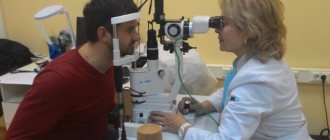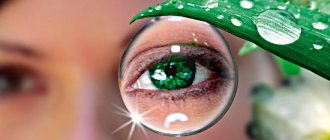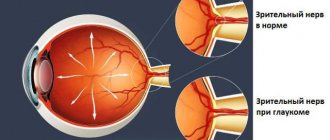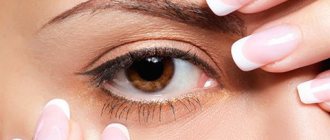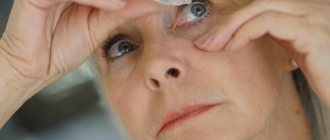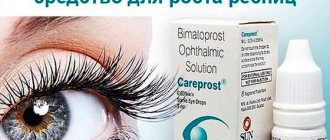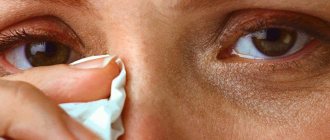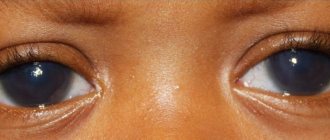An acute attack of glaucoma occurs when there is a sharp increase in ocular pressure inside the eye. Often occurs as a result of stress, hypothermia or sudden physical exertion. It is rare, but it also happens that an eye attack appears suddenly and for no reason. A person feels a sharp pain in the eye, which also provokes a headache, which is accompanied by nausea, vomiting, weakness of the whole body and pain in the heart. As a result of these symptoms, it is difficult for a doctor to diagnose acute glaucoma, so completely different diseases are treated.
If glaucoma is suspected, the patient should immediately consult an ophthalmologist, because most often surgical intervention is used to treat the acute form. In this article we will talk about an acute attack of glaucoma, symptoms, causes and modern treatment methods.
Causes
The fluid in the front of the eye is continuously produced by the ciliary body, behind the colored iris of the eye. Aqueous humor flows through the pupil and drains through the mesh through the outer edge of the iris.
In acute glaucoma, the iris protrudes forward and covers the drainage angle. The pressure inside the eye increases as more fluid is released.
Glaucoma is a progressive disease. Over time, increased pressure in the eyes can damage the optic nerve. Intraocular pressure - damages the second pair of cranial nerves.
When the optic nerve is damaged, it results in significant vision loss or even blindness within a few years. One of the most worrying aspects of glaucoma is that in the initial stages it may not cause any symptoms. However, an acute attack is a sudden jump in intraocular pressure.
In cases of acute angle-closure glaucoma, the drainage of fluid from the eye is completely blocked, resulting in an immediate increase in pressure. This causes the iris and cornea of the eye to move closer to each other, closing the angle between them. Attacks of angle-closure glaucoma occur in the following cases:
- stress;
- high physical activity;
- use of Atropine or medications containing this substance;
- hypothermia or prolonged exposure to the sun;
- drinking large amounts of liquid.
Treatment of an acute attack of glaucoma
Therapy should be aimed at restoring the normal position of the iridolenticular diaphragm and, accordingly, the natural dimensions of the anterior chamber. Prescribe hot foot baths, mustard plasters on calves, laxatives (according to indications). Hirudotherapy - leeches on the temple - is effective, as well as other methods of normalizing blood pressure in the vascular system of the eye and removing excess fluid from the vitreous body (diacarb is usually prescribed according to an individual regimen.
Risk group
The main factors, the presence of which contributes to the rapid development of pathology:
- Farsightedness - with this pathology, the risk of developing acute glaucoma increases, since the eyeball is smaller than the WHO norm.
- The disorder is more common in older people because the lens of the eye thickens throughout life and puts pressure on the iris over time. The iris bulges forward and blocks the drainage angle.
- Individuals from Asian and Caribbean populations are more susceptible to developing the pathological condition. This is due to the year-round bright sun.
This happens if the patient does not monitor the disease and does not regularly visit an ophthalmologist to prevent the development of the disease.
Symptoms
Unlike primary open-angle glaucoma, where IOP increases slowly, during an acute attack, the pressure increases suddenly. This happens within a few hours. If the pressure rises high enough, the pain can be so severe that it causes nausea and vomiting.
The eye becomes red, the cornea becomes swollen and cloudy, and the patient may see halos around light sources, vision as if in a fog. Scarring of the trabecular meshwork leads to chronic glaucoma, which is much more difficult to treat. Cataracts may also develop. Damage to the optic nerve occurs quickly and leads to permanent vision loss.
Many of these surprise attacks occur in darkened rooms. Dark environments cause the pupil to dilate or increase in size. When this happens, the angle narrows and an acute attack occurs.
But the pupil also dilates when a person is excited or nervous. Consequently, many attacks of acute glaucoma occur during periods of stress. A number of medications can also cause pupil dilation and lead to an attack. These include antidepressants, antihistamines and some medications to combat nausea.
Often the patient may have a series of small acute attacks. Manifest:
- blurred vision;
- sudden severe pain in the eye;
- the pupil, lens and iris become cloudy;
- the stroma hardens - the diseased visual organ becomes noticeably denser than the healthy one;
- the pupil does not react to light;
- photosensitivity;
- the pupil changes color to a dull gray, the effect is most pronounced in the central part.
Subjective signs of an acute attack of glaucoma include high fever, slow heartbeat, chills and cold sweats. These signs determine a true attack of the disease.
Other complaints
An acute attack of glaucoma is accompanied by specific sensations and visual disturbances. A patient who contacts a medical facility in a timely manner has a better chance of maintaining peripheral vision and the ability to see. The possibilities of first aid are greatly increased if the patient was able to correctly describe the sensations he was experiencing.
For the diagnosis of an acute attack and timely provision of first aid, the following symptoms are of greatest value:
- Fogging of the viewing area. It’s as if a cloudy veil appears before your eyes; visual acuity drops sharply, especially on the sides. Accompanied by clouding of glaucoma, revealed by visual examination. Trying to squint doesn't help you focus; along with visual acuity, color sensitivity slightly decreases. This is how acute glaucoma manifests itself in the first hours.
- Rainbow circles near light sources. A priority sign indicating increased aqueous humor in the eye. Normally, the round iridescent edging appears in the light only on a rainy day. It occurs due to the refraction of light in a medium saturated with drops of moisture. When an attack occurs unexpectedly, the constant level of moisture in the eye creates optical distortion. First aid measures remove the moisture and the rainbow glow disappears.
- Pain in the head, eyes. Changes in intraocular pressure are associated with intense headaches resembling migraines. Often (but not necessarily) accompanied by sharp, deep pain in the eye. Painkillers are ineffective; exceptions are antispasmodics and blood pressure lowering agents.
- Nausea, vomiting. Optional symptoms that occur as side effects of headache and eye pain. They are provoked by severe painful attacks and disappear after compensation for pain in the eye. For diagnosis, they should not be associated with digestive processes: vomiting is caused by intense pain, and its cause is glaucoma.
Even experienced first responders face challenges in determining the nature of an eye disease. The standard manifestations of glaucoma can be classified as general: they overlap with many diseases. To make an accurate diagnosis, the patient’s testimony is combined, the result of a visual examination and information about whether the patient has had an acute attack of glaucoma before.
First aid for acute glaucoma
Emergency assistance during an acute attack must be provided immediately, otherwise in a few hours the patient will completely lose vision.
If you discover signs of this condition, immediately contact the nearest medical facility, stop the acute attack, and then inform your ophthalmologist and make an appointment to receive the following instructions regarding treatment.
First aid for an acute attack is as follows:
- Instillation of vasoconstrictor drops - Pilocarpine, Timolol. These drugs narrow the pupil. The dosage is determined by the doctor, usually Pilocarpine is instilled according to this scheme - 1 drop every 15 minutes for 1 hour. Then instillations are reduced to 1 time per half hour and then 6 instillations during the day.
- If the attack is accompanied by pain, Promedol is prescribed. The medication is administered intramuscularly or intravenously. It quickly relieves pain.
- Additionally, diuretic medications are prescribed - Diacarb / Furosemide or others.
You should not apply mustard plasters or take hot baths if the patient’s body temperature has increased. In the opposite situation, these methods can be used; they can reduce blood flow to the visual organs. If the attack cannot be stopped within 24 hours, surgery is performed.
Glaucoma treatment
The basis of glaucoma treatment is to reduce intraocular pressure (IOP) and stabilize it at the target value. IOP can be reduced by medication, using laser surgery and microsurgery (“knife” surgery).
The main goal of glaucoma treatment is to reduce intraocular pressure (IOP) to values at which there will be no progression to narrowing of the visual fields, optic nerve atrophy and decreased visual function.
Today there are 3 methods for reducing IOP:
- Drug therapy
- Laser surgery
- Microsurgery (“knife”)
Drug treatment
In most cases, treatment of glaucoma begins with conservative methods, by prescribing medications that reduce IOP.
There are several pharmacological groups of drugs to reduce IOP: some reduce the production of intraocular fluid, others improve the outflow of this fluid from the eye. For convenience of treatment (reducing the number of instilled drugs, the frequency of their instillation during the day), combined forms of drugs have been developed, containing two pharmacological groups of drugs in one. The adequacy of the achieved antihypertensive regimen is determined by dynamic control examinations. To avoid the development of tachyphylaxis (addiction) to drugs, they should be routinely replaced with drugs from another pharmacological group.
Diagnostics
Only an ophthalmologist or optometrist can diagnose an acute attack of glaucoma. If you suspect this condition, do not take independent measures and immediately go to a specialized clinic. The ophthalmologist will analyze the patient’s complaints, prescribe an examination and, based on its results, prescribe treatment.
Patients undergo biomicroscopy. The test shows swelling of the cornea, a decrease in the anterior chamber of the eye, noticeable cloudiness and cellular inclusions. The diagnostic method also determines the level of intraocular pressure and detects the dilation of the oval pupil.
Patients with an acute attack of glaucoma undergo gonioscopy. It is performed after the swelling of the cornea has been removed. This technique allows you to identify hidden blockade of the anterior chamber of the eye.
Intraocular pressure
Measuring the tension inside the eyes is the first step when glaucoma is suspected. It is important to accurately determine the condition, since angle-closure glaucoma can easily be confused with a hypertensive crisis. An attempt to provide first aid in accordance with the standards for a hypertensive crisis will greatly increase the likelihood of irreversible vision loss.
Normal intraocular pressure does not exceed 22-24 mmHg. Values in the range from 18 to 22 mm remain unchanged due to the movement of incoming and outgoing aqueous humor. This liquid, reminiscent of blood in composition, contains virtually no protein. But it nourishes the outer areas of the eye and maintains the level of tension necessary for sharp vision.
With a sudden attack, the uniform movement of fluid stops. An untrained eye faces a load that exceeds the permissible limits by 3-4 times. The cells of the optic nerve are deformed, information from the outside of the eye is no longer received. The field of view becomes smaller, and it will no longer be possible to restore it.
Why does pressure rise in the eye?
An acute attack of glaucoma is dangerous due to its suddenness. In just a minute, the pressure in a healthy eye can jump from 22 to 60-80 mm. Hg Art. or even higher. Only first aid for an acute attack of glaucoma guarantees the preservation of vision in the event of an unexpected lesion.
The spontaneous nature of the jump does not allow us to accurately determine its causes. Among the prerequisites are:
- taking medications that temporarily increase photosensitivity (atropine, etc.);
- unexpected experience (news of the death of a relative, financial loss, etc.);
- overstrain after prolonged eye strain.
The maximum risk of an acute attack of glaucoma is in patients over 60 years of age, especially if the change does not occur for the first time. On average, one elderly person in a hundred will suffer from a sharp drop in intraocular pressure. The odds are higher for dark-skinned patients: blacks in general are more prone to angle-closure glaucoma.
Treatment
An acute attack can be stopped with a combination of drops that constrict the pupil and medications that help reduce the production of eye fluid. Once the IOP has dropped to a safe level, the ophthalmologist will perform a laser iridotomy.
Laser iridotomy - Performed in a hospital, this procedure uses a laser beam to create a small hole in the iris. Allows liquid to flow more easily. Eye drops are used before the procedure to provide anesthesia. The patient does not feel pain during the operation, only minor discomfort.
The whole procedure takes no more than 30 minutes. Laser surgery may be performed for prevention on the other eye. Considering that usually both visual analyzers suffer from a narrowing of the angle, surgery on the unaffected eye is performed as a preventive measure.
Prevention
No one from the risk group is immune from a sudden attack. Therefore, it is important to follow doctors’ recommendations and systematically carry out preventive measures. They will help prevent a sharp rise in pressure inside the eye.
Preventive actions:
- regular visits to the ophthalmologist;
- compliance with rest and work schedules;
- 8 hour sleep;
- exclusion of physical activity, if the patient has previously been involved in sports, it is possible or not to clarify;
- reduce the amount of liquid you drink at one time (this applies to water, soup, juices and fruit drinks);
- wear clothes that do not interfere with normal blood circulation (do not pull a tie or scarf tight);
- avoid stressful situations; if that doesn’t work, take medications, visit a psychologist;
- to improve blood circulation, walk more often;
- stop drinking alcohol, minimize the number of cigarettes (it is better to stop smoking altogether).

